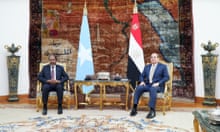The weekend seizure of two key towns on the main road to Addis Ababa has alarmed Ethiopian leaders who fear that the rapid advances by Tigrayan rebel forces may soon threaten the capital itself.
The sudden push into the towns of Dessie and Kombolcha was accompanied by short bursts of intense fighting that had reportedly subsided by Monday evening. While Dessie was confirmed to have fallen to the rebels on Sunday, the fate of Kombolcha was less clear, with accounts of continuing sporadic gunfire.
Nevertheless, the rebel offensive was the most decisive yet in the year-long conflict with Ethiopian government forces, and led the country’s prime minister, Abiy Ahmed, to call for loyalists to double efforts to defend the seat of power. “Use any type of weapons to block the destructive [rebel push], to overturn it and bury it,” he said. “Dying for Ethiopia is a duty for all of us.”
Government officials claimed, without offering evidence, that up to 100 youths had been executed during the Tigrayan takeover of Kombolcha – adding weight to rebel boasts of having seized control of the northern town.
Kombolcha residents contacted by Agence France Presse described chaos as rebels approached. “The night was filled with many gunshots,” one man told the news agency. “I heard an airstrike past midnight outside Kombolcha borders.”
A second man, Hamdiu, a shopkeeper in Kombolcha, said he heard what sounded like an airstrike in the late evening. “Huge gunshots were heard until morning”, he said. Federal government forces have frequently used airstrikes in the Tigray region as the war has ground on, but denied having done so in Kombolcha.
As fears mounted of a continued push to Addis Ababa, 380km farther south, a spokesman for the Tigray Peoples Liberation Front (TPLF), Getachew Reda, denied the organisation had designs on the capital and claimed the offensive aimed only to break the government siege on the Tigray region, which had been imposed by Ahmed in 2019.
The seeds of the fighting, which has sparked mass internal displacement and reports of a near-famine in some regions, were laid as Ahmed attempted to consolidate his authority, after taking power a year earlier, partly by merging opposition and regional political parties into his own. The TPLF, which had dominated Ethiopian politics for nearly three decades, refused to join and subsequently held regional elections that the Ahmed-led government declared illegal.
Since fighting erupted in 2019, it has drawn in troops from nearby Eritrea and Ethiopia’s Amhara region and threatened to spill even further throughout the country and across its borders to Sudan and Somalia. The war has led to frequent claims of rapes, massacre, enslavement and widespread humanitarian abuses.
Chronicling the suffering has been all but impossible, with most aid agencies, including the UN, Médecins Sans Frontières and the Norwegian Refugee Council, banned from the country, and journalists forbidden from covering the fighting. Agencies have estimated that about 4.5 million people are in need of aid, and about 1 million are in areas that are inaccessible. In June, the UN estimated that 400,000 people were already at risk of famine-like conditions.
International reaction to the Tigrayan advance has been restrained. The US secretary of state, Antony Blinken, said Washington was alarmed by the “reports of the TPLF takeover of Dessie and Kombolcha. “Continued fighting prolongs the dire humanitarian crisis in northern Ethiopia,” he said on Twitter. Regional authorities in Amhara had earlier estimated that almost 250,000 people had taken refuge in both towns, having fled fighting elsewhere in the country.
Officials in Amhara on Monday ordered government institutions to stop work and join the war effort. Before Ahmed took power, Tigrayans had held sway over much of the Ethiopian military and had brought much of that power to bear on the battlefields. Government forces, however, have control of the skies and widespread reports have emerged of Ahmed’s war effort being supported by drones supplied by the United Arab Emirates and flown from bases in nearby Eritrea.
AFP contributed to this report









